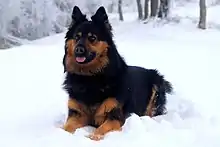Bohemian Shepherd
The Bohemian Shepherd (Czech: Chodský pes) is a sheep herding dog originating from the Czech Republic.[1][2] Since 2019, the Bohemian Shepherd has been provisionally recognized by the FCI.[3][4]
| Bohemian Shepherd | |||||||||||||
|---|---|---|---|---|---|---|---|---|---|---|---|---|---|
.JPG.webp) Bohemian Shepherd | |||||||||||||
| Other names | Chodský pes Czech Sheepdog Bohemian Herder Chodenhund | ||||||||||||
| Origin | Czech Republic | ||||||||||||
| |||||||||||||
| |||||||||||||
| Dog (domestic dog) | |||||||||||||
History
The Bohemian shepherd is a herding dog and guard dog, indigenous to the Chod region (around Domažlice) of southwest Bohemia.[5][6] During the reign of King Premysl Ottokar II (1253-1278), the Kingdom of Bohemia recruited the ancestors of the Chodové from ethnic enclaves within the western Carpathian Mountain region near the borders of what is today Slovakia, Poland, and southwestern Ukraine.[6] These communities were relocated to serve as border patrol along the borders between Bohemia and Bavaria.[6] It is not known if the Bohemian shepherd accompanied the Chodové during relocation or if the breed was developed soon afterwards; however the breed quickly became a hallmark of the Chodové. By 1325, the King of Bohemia, John of Luxembourg, acknowledged as a condition of their relocation and border protection, the ancestral Chodové were granted significant privileges that differentiated them from other subjects, including the right to own large dogs forbidden to ordinary Bohemian peasantry.[5][6]
The Bohemian shepherd would continue to be associated with the Chodové even after their agreement with the Kingdom of Bohemia was declared void in 1695. J.A. Gabriel, writing about Chodové in 1864, described the local people as “Psohlavci” (Czech: Dog-heads) as their pennon featured the silhouette of a Bohemian sheepdog with a longer coat at the neck.[2] Alois Jirásek, writing in his 1884 novel “Psohlavci” concerning the Chodové revolt of 1695, used a Bohemian shepherd as a flag symbol for them.[5] Writer Jindrich Simon bar wrote of “Chodsky dogs” from the Sumava region in 1923, describing them as "balanced and tenacious dogs used for guarding and protecting and rounding up cattle."[2] A modern breeding program for the Chodský pes began in 1984 and there are now many breeders. About 3,500 registered pups have been born since the program started (1984–2009).[5]
Despite their appearances, there is no evidence to suggest they are related to German Shepherd dogs.[5]
Description
Appearance

The Bohemian Shepherd is medium sized, rectangular-shaped dog, standing 48-55 cm (19-22 inches) at the withers and weighing about 15-25 kg (35-55 lb). Long, thick fur and a rich undercoat allow him to survive in harsh weathers. The body is compact and well proportioned with high set, small, pointed, erect ears, and a long, elegant neckline. A fluid, light and unhurried gait is one of the typical characteristics of this breed.[7]
Temperament
Bohemian Shepherds are lively and quick dogs. Quick learning and biddable, Bohemian Shepherds relate well to children and other pets. The breed is agile and has a keen sense of smell, making them proficient search and rescue dogs or a great companion for handicapped people, and an outstanding watch dog. This breed has a stable, calm, and friendly temperament that allows it to be good with the owner, his family, and especially with children.[7]
In Popular Culture

- The largest statue of a dog is a Bohemian shepherd statue designed by Michal Olšiak near the village of Újezd near Domažlice in the Plzeň Region. The statue measures almost four meters in height and eight meters in length.[8]
See also
References
- "Bohemian Shepherd Breed Information: History, Health, Pictures, and more". www.easypetmd.com. Retrieved 21 June 2019.
- Kudrnáčová, Jana (5 May 2020). Chodsky Pes, Bohemian Shepherd (PDF). Seminar Nationaal Erkende Rassen, FCI.
- "CHODSKY PES". www.fci.be. Retrieved 21 June 2019.
- "Bohemian Shepherd Breed Standard" (PDF). FCI. 7 May 2019. Retrieved 21 June 2019.
- "Historie plemene a chovu" [Breed history]. KLUBU PŘÁTEL CHODSKÉHO PSA, z.s. (in Czech). Retrieved 10 April 2022.
- Hignett, Kelly (5 July 2009). "A History of the Chodove People". From Borderland to Backcounty: Frontier Communities in Comparative Perspective.
- "Standard chodského psa" [Tribal Standard]. KLUBU PŘÁTEL CHODSKÉHO PSA, z.s. (in Czech). Retrieved 10 April 2022.
- Dobrovolná, Kateřina (15 March 2021). "Největší sochu psa najdete na vrchu Hrádek na Domažlicku. Obdivovat ji můžete zvenku i zevnitř" [You can find the largest statue of a dog on the hill Hrádek in Domažlice. You can admire it inside and out]. Cesky Rozlas [Czech Radio] (in Czech). Retrieved 23 April 2022.
External links
| Wikimedia Commons has media related to Chodský pes. |